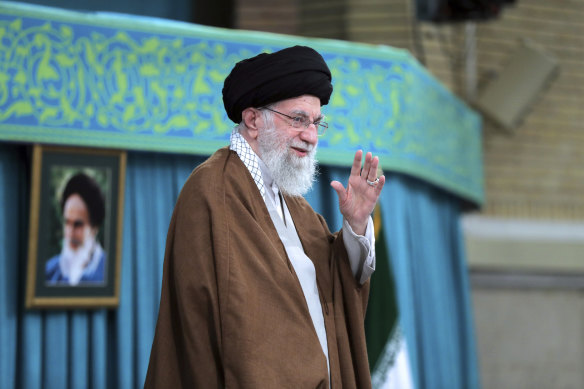Opinion
Why Iran may now choose surprise as its weapon of choice against Israel
Rodger Shanahan
Middle East and security analystThe undeclared proxy war between Iran and Israel is out in the open. As Israel has expanded its military aims from full-scale offensive military operations to degrade Hamas in Gaza, through defensive and then offensive air and ground operations in Lebanon, we have now arrived at what was previously considered the worst-case scenario – acknowledged direct attacks between Israel and Iran on each other’s territory.

Iranian Supreme Leader Ayatollah Ali Khamenei in Tehran on Sunday.Credit: AP
This was previously the red line that neither side would cross because of fears it would lead to a broader regional conflict. But the regional security landscape is much different to that of a year ago. Iran’s system of a layered defence has relied on friends, allies and proxies on Israel’s border or within striking distance of it, who could be used to increase the cost to Israel of any attack against Iran.
Now, however, Hamas is effectively neutered as a serious military threat for the foreseeable future; Hezbollah is still capable but under great pressure on the ground and reorganising after its senior leadership has been decimated; the Houthis are an irritant whose logistical hubs are vulnerable to both Israeli and US air attacks; and Syrian and Iraq-based support groups have been maintaining a relatively low profile lest they become priority targets.

A photo provided by Israel’s army shows Israeli planes departing from an unknown location to attack Iran.Credit: AP
The pressure placed on its support groups has meant that Iran has now had to resort to direct responses using its rocket, drone and missile forces. For all its public rhetoric, Tehran understands the risks involved in a direct confrontation with Israel, which enjoys air supremacy and, through its Western support network, technical and intelligence superiority. After Israel’s targeting of the Iranian diplomatic compound in Damascus in April, Tehran had little choice but to directly respond.
In doing so, however, it favoured scale over effectiveness. Most crucially, it deliberately forsook that key element in military operations – surprise. Iran’s strategic aim was to react and more importantly, to be seen to react, without doing too much damage or killing too many people. Tehran telegraphed its intent well in advance and allowed Israel sufficient time to put together a multinational air defence umbrella that provided further protection. That umbrella naturally works much better with sufficient warning.
Six months later, Iran’s second rocket and missile attack was conducted in response to Israel’s killing of the Hamas leader in Tehran, Hezbollah secretary-general and closest ally Hassan Nasrallah and the Iranian Revolutionary Guard Corps deputy chief of operations, brigadier Abbas Nilforoushan. This time, the attack was conducted with far less warning and with a far greater percentage of the more effective ballistic missiles than previously. Their ability to penetrate Israeli defences was therefore much greater.
Israel’s unprecedented direct response in this international aerial tit-for-tat was restrained, yet calibrated. From what we know, Israel targeted some Iranian air defence assets and establishments connected to Iran’s rocket and missile production industry.
Four Iranian military personnel were killed. Reports also indicate that Israel provided some regional states with forewarning of the attack, on the understanding that Tehran would be informed. Iranian airspace was penetrated and a limited set of targets were attacked. Once again, the emphasis was on messaging: strategic effect on targets was a real but secondary aim. The sub-text, that future moves towards a nuclear capability by Iran would be equally vulnerable, was clear.
Both sides are now likely to step back and draw breath, while absorbing the lessons of their respective actions. In the strategic context of the Middle East, the boundaries of what passes for accepted behaviour are often being pushed, sometimes crossed and then reset. But rarely if ever in the way we have seen in the past year. Hamas’ attack on October 7 crossed a red line and consequently, Israel has been redefining what “military necessity” and “proportionality” means, first in Gaza, and now in Lebanon.
The boundaries in the Iran-Israel shadow war have now been radically reset with direct attacks on each other. For the moment, both seem content with sending dangerous messages to each other, while still exercising restraint.
In this transnational contest of wills, however, Iran knows it is very much the weaker military player. The real danger will come if Tehran decides to employ the one military element that both sides have refrained from using to date – surprise.
Dr Rodger Shanahan is a Middle East and security analyst and an author.